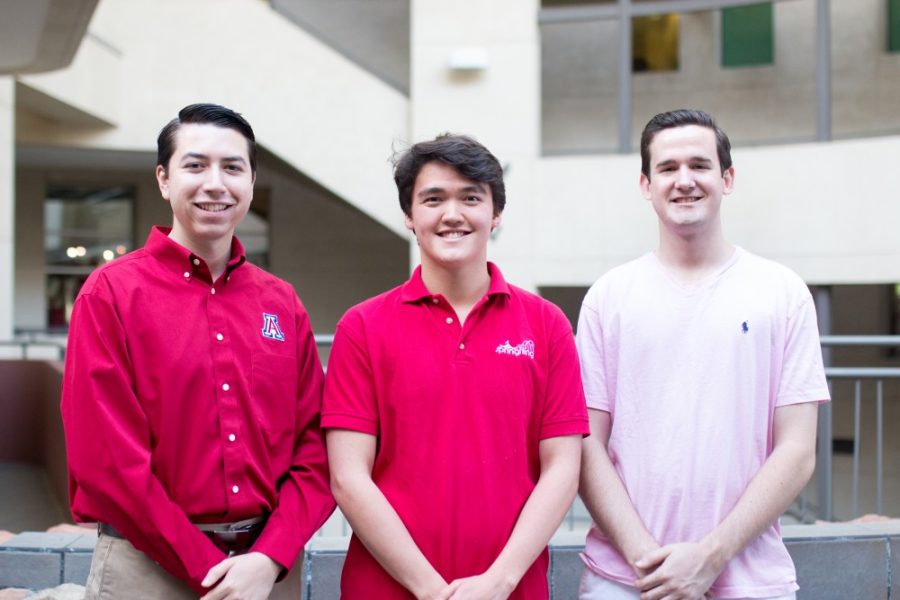The Associated Students of the University of Arizona is currently in the process of creating the Arizona Student Government Collaborative, an organization that will bring Arizona’s three public colleges’ student governments together to better serve their students.
“We really wanted to put aside the differences and leave the rivalries on the court to bring the student governments together,” ASUA President Manny Felix said. “It’s powerful when you have over 100,000 students working toward a common goal.”
Felix said that while they’re proud to say this generated from the UA, the other two universities are on board and excited about ASGC.
They approached Arizona State University and Northern Arizona University student presidents about the idea, and the three have drafted ideas and have been discussing the details ever since, Felix said at the first Arizona Board of Regents meeting last fall.
They’re making sure everyone is involved and has a chance to give input, but they’re hoping to have something more official established by the next regents meeting in April so they can present it to the board, Felix said.
“It’s important to have the entire student bodies from the three campuses all together and ready to stand up for our universities and Arizona overall,” Felix said. “And this program does just that.”
He said there hasn’t been much collaboration between the universities in the past, despite facing the same challenges such as budget cuts and affordable education.
Felix added that he’s not worried about the collaborative efforts being lost when Mikey Finnegan, the incoming president, takes over next year because he’s been helping with planning, writing bylaws and working with the policy team.
Spencer Bateman, a UA junior studying finance and political science and executive director of government affairs and policy, said the reason they decided to pursue this is because the lack of coordination between student governments in recent years has damaged their efforts at the state policy level.
“Instead of going to the legislature with the view of Arizona students, we go in with the view of UA students, NAU students and ASU students,” Bateman said. “It’s better if we have a coordinated student effort behind things, because it allows us to reach more of an audience and gives us a lot more legitimacy and weight.”
Vianney Careaga, a political science sophomore and director of civic engagement, said that while everything is still in the works, the three governments have come together and formed the mission statement of ASGC.
The mission is “to serve the students of Arizona state’s public universities as the representative student voice at campus, local, state and national levels through education, advocacy and outreach,” Careaga said.
Finnegan said they are still in the works of writing bylaws and establishing how the structure will work, but that this will be about representing all students and the three universities fairly.
There would be a general assembly that has the opportunity to send recommendations and resolutions up to an executive committee that will be comprised of the three universities’ presidents.
“Every university has one vote, so everything has to be unanimous or it won’t be passed,” Finnegan said.
ASU, with its multiple campuses around the Phoenix area, will figure out how its voting process will work to determine its one vote.
Careaga said whatever resolutions, recommendations or ideas originate from ASGC will have to be approved through each university’s internal process in place, like the ASUA Senate, to ensure that ASGC is representing every student and each university’s voice.
He added that they’re working on writing in the bylaws so that every few years, they have to go through each student government for recharter to ensure they’re still working and are unanimously approved by the schools.
As far as ratifying the collaborative itself, Finnegan said they’re going to get them approved by each university’s student government to ratify and recognize it’s existence.
Even though the end of the semester is approaching, Finnegan, as president-elect, said he will continue to work and be a part of ASGC to make sure it happens.
“We’re all very committed to this and regardless of who’s in our positions next year, there’s definitely going to be an effort on our part of to see this through,” Bateman said. “This has definitely been the focal point of the policy team this year.”
The current policy teams have invited the incoming president-elects to come to a briefing at the upcoming regents meeting to make sure that everyone is on the same page heading into next year, according to Careaga.
“For the past four years, we basically haven’t had anyone who represented us as a student voice,” Finnegan said. “Hopefully we will, for not just now, but for a long time.”
Follow Chastity Laskey on Twitter.









